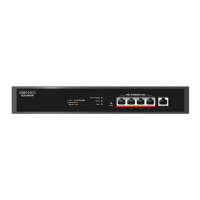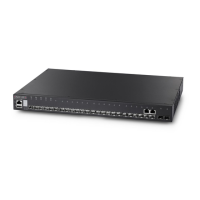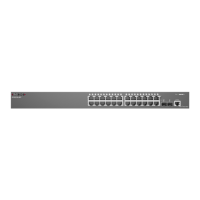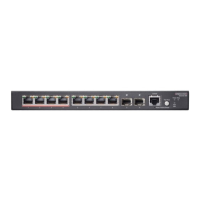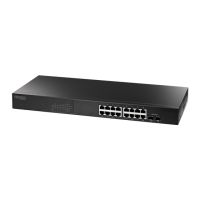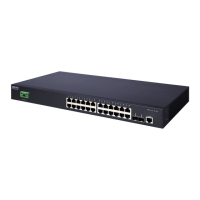C
HAPTER
8
| Spanning Tree Algorithm
Configuring Global Settings for STA
– 208 –
This creates one spanning tree instance for the entire network. If
multiple VLANs are implemented on a network, the path between
specific VLAN members may be inadvertently disabled to prevent
network loops, thus isolating group members. When operating multiple
VLANs, we recommend selecting the MSTP option.
◆ Rapid Spanning Tree Protocol
3
RSTP supports connections to either STP or RSTP nodes by monitoring
the incoming protocol messages and dynamically adjusting the type of
protocol messages the RSTP node transmits, as described below:
■
STP Mode – If the switch receives an 802.1D BPDU (i.e., STP BPDU)
after a port’s migration delay timer expires, the switch assumes it is
connected to an 802.1D bridge and starts using only 802.1D
BPDUs.
■
RSTP Mode – If RSTP is using 802.1D BPDUs on a port and receives
an RSTP BPDU after the migration delay expires, RSTP restarts the
migration delay timer and begins using RSTP BPDUs on that port.
◆ Multiple Spanning Tree Protocol
MSTP generates a unique spanning tree for each instance. This provides
multiple pathways across the network, thereby balancing the traffic
load, preventing wide-scale disruption when a bridge node in a single
instance fails, and allowing for faster convergence of a new topology for
the failed instance.
■
To allow multiple spanning trees to operate over the network, you
must configure a related set of bridges with the same MSTP
configuration, allowing them to participate in a specific set of
spanning tree instances.
■
A spanning tree instance can exist only on bridges that have
compatible VLAN instance assignments.
■
Be careful when switching between spanning tree modes. Changing
modes stops all spanning-tree instances for the previous mode and
restarts the system in the new mode, temporarily disrupting user
traffic.
PARAMETERS
These parameters are displayed:
Basic Configuration of Global Settings
◆ Spanning Tree Status – Enables/disables STA on this switch.
(Default: Enabled)
◆ Spanning Tree Type – Specifies the type of spanning tree used on
this switch:
■
STP: Spanning Tree Protocol (IEEE 802.1D); i.e., when this option
is selected, the switch will use RSTP set to STP forced compatibility
mode).
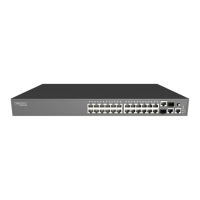
